December 2025

The global primary cell culture market size is expected to grow from USD 7.41 billion in 2025 to USD 20.62 billion by 2034, with a CAGR of 12.05% throughout the forecast period from 2025 to 2034.
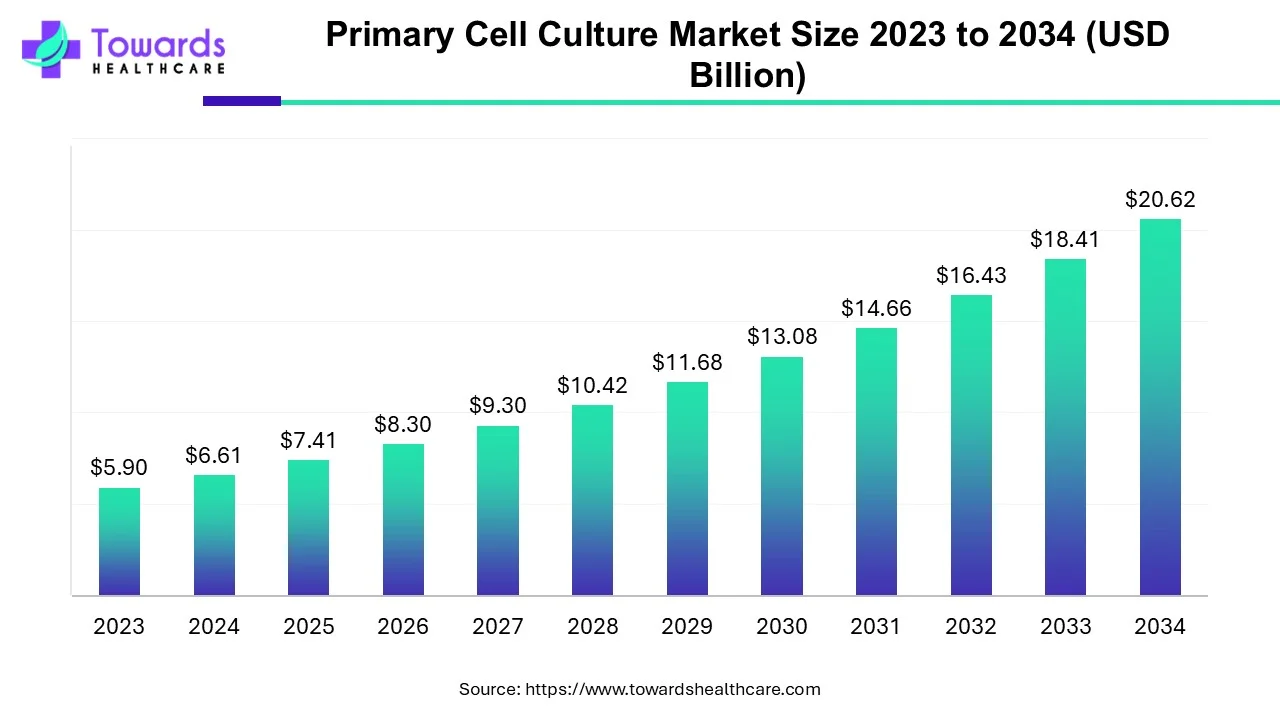
| Metric | Details |
| Market Size in 2024 | USD 6.61 Billion |
| Projected Market Size in 2034 | USD 20.62 Billion |
| CAGR (2025 - 2034) | 12.05% |
| Leading Region | North America |
| Market Segmentation | By Product, By Separation Method, By Cell Type, By Application and By Region |
| Top Key Players | Thermo Fisher Scientific, Inc., Bioserve India, ATCC, Mattek, Corning Incorporated, FUJIFILM Irvine Scientific, Inc., Lonza, PromoCell GmbH, Merck, Danaher, Axol Bioscience Ltd. |
Primary cell culture is the process of removing cells from multicellular organisms and culturing them in ex-vivo conditions. The primary cell culture market is growing due to the growing research and development due to the growing prevalence of chronic conditions. Cell cultures are highly useful in studying the biochemistry and physiology of cells. Some of the areas in which cell cultures are used are cancer research, virology, toxicity testing, drug screening and development, vaccine production, development of bio-products, organ development, and so on. As the geriatric population grows, the demand for cell culture will also grow, which will encourage governments, key players, and different organizations to take steps to promote the growth of the primary cell culture market.
The inclusion of AI in the primary cell culturing process promotes better outcomes. Researchers can take a co-piloted approach or make cell culture procedures completely autonomous by using AI-driven automation and decision-making. This promotes repeatability and consistency across 2D and 3D cell culture workflows in addition to standardizing procedures.
For instance,
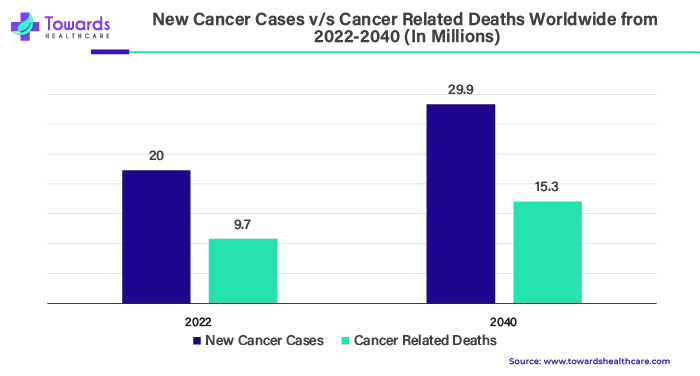
Cancer is a growing threat to society and needs continuous attention. According to the World Health Organization, lung cancer is the most common type of cancer, which led to 2.5 million new cases in 2022, followed by female breast cancer with 2.3 million new cases, colorectal cancer with 1.9 million cases, and 1.5 million new cases of prostate cancer.
The primary cell culture market is growing due to the prevalence of cancer. Primary cell cultures have wide applications in cancer research, diagnosis, development of treatment options, drug development, and so on. Primary cells may be subjected to radiation, chemicals, or viruses as part of cancer research to observe how they react. Consequently, research may be done on the changed signaling route, as well as the mechanism and etiology of cancer. These cells might potentially be used to investigate how well medications work against cancer cells.
The challenges associated with discovering and obtaining primary cells for research and production in the primary cell culture market are known as the restricted availability restriction. Because primary cells are made directly from tissues and have a short lifespan, they are expensive and scarce. Small numbers of viable cells may be produced only by technically challenging isolation techniques. Tight regulatory controls, donor unpredictability, and ethical limitations further restrict their availability.
The world's experts have only recently started to take an interest in 3D culture because of its rapid and promising technical advancements and several significant discoveries. Three-dimensional models of organs are more therapeutically useful since they more precisely reflect the organ in vivo condition. This leads to more accurate and predictive data being obtained from these models concerning stem cell research, drug screening, normal and malignant traits, and cell-cell interactions.
By product, the reagents and supplements segment held the largest share of the primary cell culture market in 2023. Primary cells are grown in artificial conditions; therefore, it is necessary to provide all the necessary supplements for growth. Apart from this, reagents are needed for cell separation, isolation, washing, cell lysis, cell transfer, prevention of contamination, and so on.
For instance,
By separation method, the enzymatic degradation segment accounted for the largest share of the primary cell culture market in 2023. The enzymes that are most frequently utilized in tissue disaggregation include crude forms of DNase, hyaluronidase, collagenase, elastase, pronase, and dispase, either alone or in different mixtures. The most common enzyme used for tissue disaggregation is crude trypsin because it is effective on a wide range of tissues and is generally well-tolerated by cells.
For instance,
By separation method, the mechanical separation segment is anticipated to grow at the fastest rate in the primary cell culture market during the forecast period. The least complex of the three is mechanical dissociation, which includes chopping, crushing, or scraping tissue to physically rupture it. This method often involves employing a device akin to a mortar and pestle to smash the retrieved material into bits. Mechanical cell separation is quick and easy, and it is useful when working with weakly linked samples. There is no need to wait for physical separation to occur.
By cell type, the animal cells segment dominated the primary cell culture market in 2023. There are various applications of animal cell culture that promote its usage. For instance, for animals to produce vaccinations, animal cell cultures are utilized to multiply the viruses. Research on the impact of novel medications, chemicals, and cosmetics on the development and survival of various cell types is conducted using animal cell culture. Animal cells that have been cultured are utilized to manufacture viruses, which are then employed to make vaccinations. Gene-engineered proteins with commercial significance including insulin, hormones, monoclonal antibodies, and many more, are produced in animal cell cultures. Animal cells can be utilized to grow new organs or tissues.
By application, the cell & gene therapy development segment held the dominant share of the primary cell culture market in 2023. Animal cell cultures can be utilized for clinical or therapeutic purposes, including genetic engineering and gene therapy. It is feasible to alter and swap out patient-derived cells for ones that have the desired working gene. An approach is to use viral vector technology to insert the missing gene or edit the genome to correct the damaged genes.
For instance,
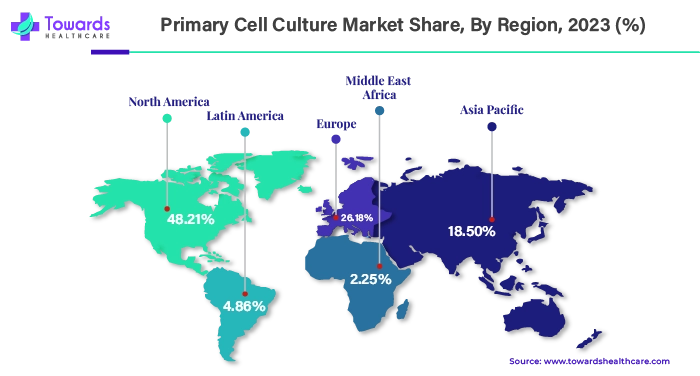
By region, North America dominated the primary cell culture market by 48.21% in 2024. Many factors, such as the high expense of healthcare, the aging population, the increased incidence of chronic illnesses, and government support, are blamed for the Region's growth. The market's growth in the area is also being aided by industry participants' increasing focus on developing cutting-edge uses for equipment, cell culture, easy access to a variety of cell kinds, and interactions between cells.
The U.S. government is supporting the growth of the primary cell culture via various investments. The U.S. regulators are also supporting organizations that are using cell culture to develop new products.
For instance,
Apart from this, the growing prevalence of cancer in the U.S. is boosting the primary cell culture market’s growth. Cell cultures are highly useful in various research and development associated with cancer.
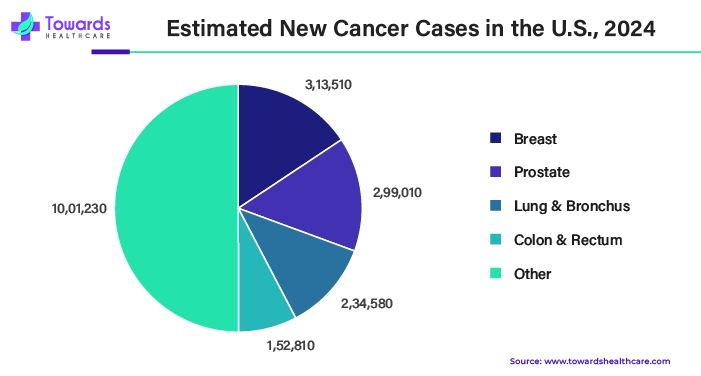
By region, Asia Pacific is expected to grow at the fastest rate during the forecast period. The Asia Pacific area has become a prominent participant in the cell culture sector, which has experienced enormous development in recent years. Growing demand for biopharmaceuticals, increased funding for life sciences research, and advancements in healthcare infrastructure are driving the market.
Asia Pacific is estimated to host significant growth in the primary cell culture media market during the forecast period. Asia Pacific is experiencing growth in the healthcare sector. At the same time, the rising incidence of various diseases and infections is increasing the demand for new diagnostic and treatment approaches. Thus, the adoption of new technological advancements, as well as skilled staff, is improving the manufacturing process. At the same time, new developments are also rising in the industries for different diseases. Thus, all these factors contribute to enhancing the market growth.
For instance,
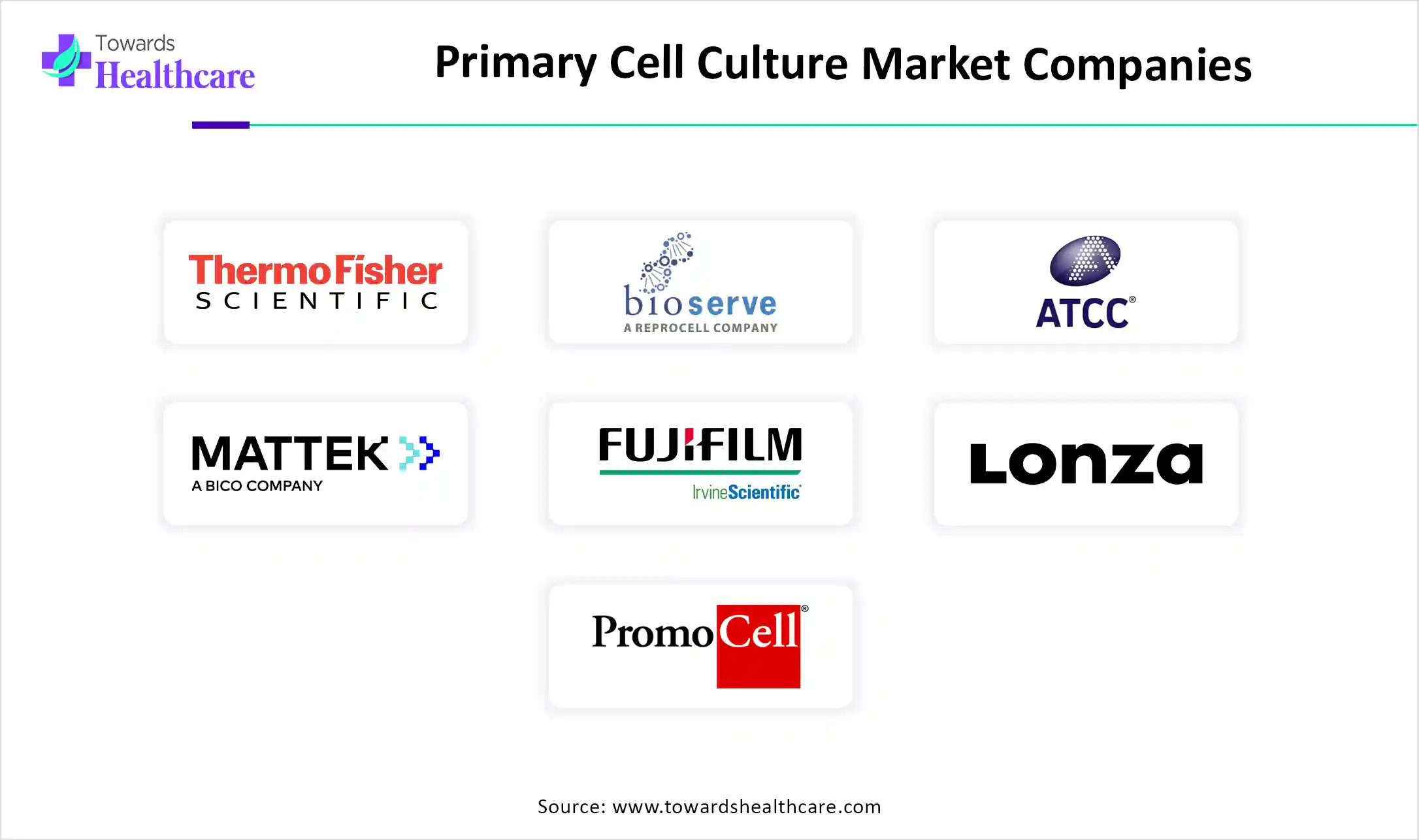
| Company Name | Bioserve India |
| Headquarters | Telangana, India, Asia Pacific |
| Recent Development | In July 2024, the advent of Bioserve India's state-of-the-art stem cell products in the nation is announced with tremendous excitement. Improvements in regenerative medicine, therapeutic discoveries, scientific research, and innovative medication development are all anticipated in the Indian market with the support of these new REPROCELL solutions. |
| Company Name | Toyo Seikan Group Holdings Ltd. |
| Headquarters | Tokyo, Japan, Asia Pacific |
| Recent Development | In May 2024, the company announced the launch of the CELLSOLUT website, which provides information about the latest research funding, cell cultures, and report descriptions. It will also provide various cell culture-related products. A product in the lineup called "WELLBAG" is a closed-system culture bag that uses cutting-edge technology to generate spheroid formation. It is mainly intended for use by researchers in academic institutions and pharmaceutical firms. |
By Product
By Separation Method
By Cell Type
By Application
By Region
December 2025
December 2025
December 2025
November 2025